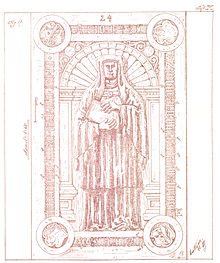Bernhard Cloenewinkel

Bernhard Cloenewinkel , also Clonewinkel , Klonewinkel (* in Lübeck ; † August 26, 1548 ibid) was a Lübeck canon .
Life
Bernhard Cloenewinkel was the son of the Lübeck citizen Cordt Cloenewinkel, who possibly belonged as a merchant to the Skåne drivers in Lübeck. He studied and graduated with a master's degree before he went to Rome , where he was first attested in 1520 as a witness of a notarization by the Rotanotary Johannes Sander from Nordhausen through documents from the environment of the curia and the notes of the Lübeck resident Thomas Giese in his notebook . His name often appears as a procurator or witness in documents from Roman Rotanotaries or notaries of the papal chamber, almost always in connection with the trade of benefices - not just Lübeck . He was in business contact with Thomas Giese in Rome from 1520 onwards. In 1522 Giese sold a vicarie to Cronewinkel with a pension reservation. Since the Lübeck cathedral chapter had already given the vicarie to Antonius Sluter, a lengthy process resulted that only ended with a settlement in 1537. Cloenewinkel temporarily owned five Lübeck vicarages: Cathedral No. 17, 28 and 31; Marien No. 3 and Petri No. 20. He lost Cathedral 17 through trial; He voluntarily resigned Dom 28; in comparison, he renounced the vicarie Dom 31 and received a vicarie in Schwartau .
After Giese's death, Bernhard Cloenewinkel entered the Lübeck cathedral chapter from Rome. In June 1528 the Lübeck councilors Joachim Gercken and Hinrich Kerckring, together with the procurator Eberhard Halholscho, presented to the chapter Cloenewinkel's wish for a Lübeck canonical, supported by a papal commission, which was complied with in the absence of Cloenewinkel. He received the preamble of the papal family Franz Diemann, who died in 1527 . The usual oath was taken for him by his procurator to the chapter. Cloenewinkel himself did not return to Lübeck until June 1530 to take up his canon position in person. In 1540 he was appointed by Bishop Balthasar Rantzau to the scholaster of the Lübeck chapter, that is to say to the head of the cathedral school in Lübeck .
He was buried in Lübeck Cathedral , where his heavily worn figure grave plate with individualized facial features has been preserved. It shows him, already in the style of the Renaissance , with a book in his hands under a round arch with a cone . In 1544 he lived with his famula Elisbeth Kloppenborch on a plot of land he had acquired outside the actual cathedral district near the upper Dankwartsgrube . He left three children.
literature
- Theodor Hach : The beginnings of the Renaissance in Lübeck. Rahtgens, Lübeck 1889, p. 24 and illustration on panel X in the appendix (drawing by Max Metzger ). Digitized at Commons
- Johannes Baltzer , Friedrich Bruns : The architectural and art monuments of the Free and Hanseatic City of Lübeck. Issued by the building authorities. Volume III: Church of Old Lübeck. Dom. Jakobikirche. Aegidia Church. Verlag von Bernhard Nöhring, Lübeck 1920, p. 257. (Unchanged reprint 2001: ISBN 3-89557-167-9 )
- Klaus Krüger: Corpus of medieval grave monuments in Lübeck, Schleswig, Holstein and Lauenburg 1100-1600 , Jan Thorbeke Verlag, Stuttgart 1999, p. 702/703 (LÜDO299)
- Christiane Schuchard, Knut Schulz: Thomas Giese from Lübeck and his Roman notebook from 1507 to 1526 . Lübeck 2003, pp. 25-29
- Wolfgang Prange : Directory of the canons. In: Ders .: Bishop and cathedral chapter of Lübeck: Hochstift, principality and part of the country 1160-1937. Lübeck: Schmidt-Römhild 2014 ISBN 978-3-7950-5215-7 , p. 347f No. 27
Web links
Individual evidence
- ↑ Christiane Schuchard, Knut Schulz: Thomas Giese from Lübeck and his Roman notebook from 1507 to 1526 , p. 26 assume that Franz Grambek from Lübeck could have brought Cloenewinkel to Rome.
- ^ Wolfgang Prange : Bishop and cathedral chapter of Lübeck: Hochstift, principality and part of the country 1160-1937. Lübeck: Schmidt-Römhild 2014 ISBN 978-3-7950-5215-7 , p. 258; detailed description by Wolfgang Prange: Vicariates and Vicars in Lübeck up to the Reformation. (= Publications on the history of the Hanseatic city of Lübeck. Series B, vol. 40). Schmidt-Römhild, Lübeck 2003 ISBN 3-7950-0478-0 , p. 71
- ↑ Wolfgang Prange: Vicariates and Vicars in Lübeck up to the Reformation. (= Publications on the history of the Hanseatic city of Lübeck. Series B, vol. 40). Schmidt-Römhild, Lübeck 2003 ISBN 3-7950-0478-0 , pp. 71 and 145, No. 74
| personal data | |
|---|---|
| SURNAME | Cloenewinkel, Bernhard |
| ALTERNATIVE NAMES | Clonewinkel, Bernhard; Klonewinkel, Bernd |
| BRIEF DESCRIPTION | Lübeck Canon |
| DATE OF BIRTH | 15th century or 16th century |
| PLACE OF BIRTH | Lübeck |
| DATE OF DEATH | August 26, 1548 |
| Place of death | Lübeck |